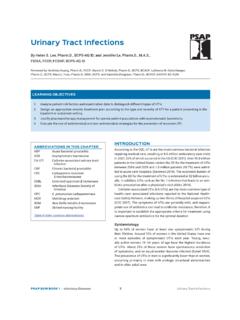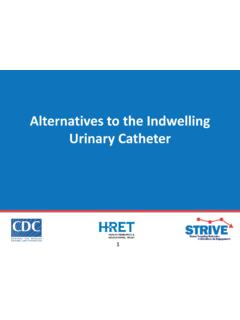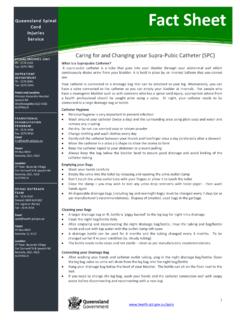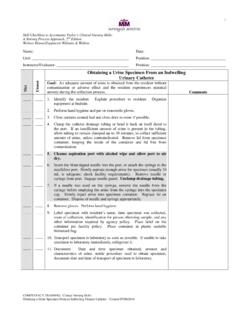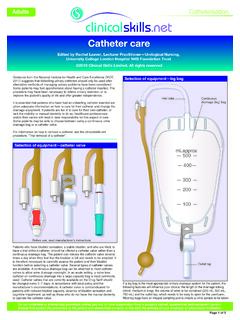Transcription of Catheter Flushing - Hospice of Cincinnati
1 Flushing Urinary Catheters: Patient/Caregiver TrainingHospice of CincinnatiHospice of HamiltonFlushing Urinary CathetersTraining: Flushing Urinary Catheters. 2019 Hospice of CincinnatiUrine is created in the kidney, flows through tiny tubes called ureters and collects in the bladder. When a Catheter is used, it is inserted in the urethra which is the tube that drains the bladder. That Catheter tube has a balloon on the end which is inflated once in the bladder, so it doesn t fall out. indwelling catheters may be helpful if: You are unable to empty your bladder (either partially or completely) You have redness or irritation of your skin from urine You are unable to get up to use the bathroom due to pain or weaknessTwo common types of indwelling urinary catheters are:1.
2 Foley Catheter : Inserted through the urethra and into the bladder, allowing urine to drain from the bladder into a collection bag outside of the Suprapubic Catheter : A flexible tube that is surgically inserted through the abdominal wall into the bladder, allowing urine to drain from the bladder into a collection bag outside of the Catheters: Removing a BlockageAt times the Catheter may be blocked or slow to drain. This may be fixed by Flushing the Catheter with saline solution, helping to move the particles that are clogging the tube. Supplies Needed: Each Catheter irrigation kit, includes: A. Catheter syringe 60 mlB. Collection containerC. Paper drapeD. Drainage trayE. Catheter plugF. An alcohol pad Normal saline irrigation solution Extra alcohol pads GlovesQuestions or concerns?
3 Call a Hospice nurse at 513-891-7700. For caregiving tips visit of CincinnatiHospice of HamiltonQuestions or concerns? Call a Hospice nurse at 513-891-7700. For caregiving tips visit for the Caregiver:1. Wash your hands with soap and water. 2. Dry well and put on Open the Catheter irrigation Open the Catheter securement device (ex: Stat Lock) and remove the tubing from the device. 5. Unfold the paper drape and place it under the connection between the Catheter tube and the drainage bag. *Caution: Never jerk or pull on the Catheter tubing. 6. Pour room temperature normal saline irrigation solution into the collection container. *Caution: Never use a cold solution to irrigate a bladder7. Draw up 60 ml into Catheter tipped syringe.
4 8. Cleanse the site where the Catheter tubing and the drainage bag tubing connect with an alcohol swab. 9. Gently disconnect the Catheter tubing from the drainage bag tubing. *Caution: Avoid touching the ends of the Catheter tube, drainage bag tube, or the Catheter tip Place the Catheter plug into the end of the drainage bag tubing and set Insert the tip of the syringe in the Catheter tubing. Gently push the solution into the bladder. *Caution: Never force fluid into the Catheter tubing. If you feel resistance, gently pull the Catheter syringe plunger back and try to push the solution in again. If you continue to feel resistance, STOP and contact Hospice . There may be an uncomfortable sensation with the irrigation, but not pain.
5 If pain occurs, stop the irrigation and call Hospice . 12. Remove the syringe from the Catheter tubing and allow the irrigation solution to flow back out of the bladder and into the drainage tray. 13. After all of the solution has drained, wipe the end of the Catheter tube with an unused alcohol pad. 14. Wait a few seconds for the alcohol to dry. 15. Remove the Catheter plug from the drainage bag tubing and reconnect the Catheter tube to the drainage bag tubing. Be sure to reattach the Catheter tube to the patient s thigh using the Catheter securement device (ex: Stat Lock). *Caution: Never jerk or pull on the Catheter tubing. 16. Discard the used irrigation solution by Flushing it down the toilet. 17. Remove and throw away gloves.
6 Wash hands with soap and water. Care of Supplies: Clean the collection container, Catheter syringe and drainage tray with hot soapy water and rinse well. Allow to air dry before using againTraining: Flushing Urinary Catheters. 2019 Hospice of Cincinnati

